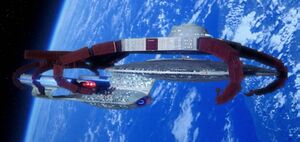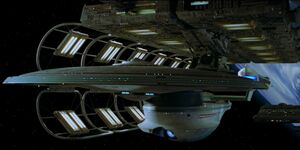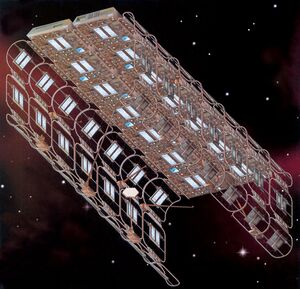Drydock
Drydocks are specialized space stations intended to support starships during construction, refit, and repairs. While this term can informally refer to any facility capable of building and servicing starships, in Starfleet parlance it refers specifically to a type of space station with an open frame that provides starships with external power, life support, and radiation shielding, as well as storage space for construction vehicles and supplies. The term 'spacedock' is also used as shorthand, but in proper terms it refers to the largest classes of Starfleet installation.
Drydock Types
Drydocks come in all shapes and sizes, some built to support a particular class of starship, but most capable of handling all ships of a certain size category. Currently, Starfleet employs four standard drydock types, two to handle Starfleet's largest ships and two to handle smaller classes. Most drydocks can't embark a permanent crew and rely on either habitat and administrative stations nearby or planet-side facilities.
Class-10 Drydock
The first drydock of this class was the primary orbital facility for Earth Station McKinley, which was built to support Galaxy-class and Nebula-class starships. This class of drydock has many articulated arms which can be reconfigured to support nearly any class of starship. They also have extensive onboard facilities, including design labs, power systems, and observation areas to support massive repair crews.
These stations are relatively rare, with most shipyards having only a handful, if any, given that they are meant to support the fleet's largest, rarest starships. They are also currently the only class of drydock that can support a semi-permanent crew, thanks to a large habitation module on the ventral surface. Typically, crews occupy this area in rotations between the drydock and whatever station or shore facility serves as the main administrative complex for the shipyard.
Class-9 Drydock
Built to handle starships as long as the Sovereign-class, Class-9 drydocks are simpler in form and function than the class-10, consisting of a cage-like frame that provides support for a large starship. These have become increasingly common as Starfleet's standard facility, as they can handle nearly any starship class narrower than the Galaxy and Nebula. Specialized docking ports can be attached to this frame which can connect directly to the shuttle bay on a starship, but this is only done when a vessel is docked for extensive, long-term repairs or refits.
When servicing smaller vessels, a station of this class could handle multiple frigates or escorts instead of a single large starship, but its efficiency would be diminished. Habitable space is located on the upper level of the drydock, with two larger modules on either end for command and control spaces and engineering workspaces spread throughout the long interconnecting struts. When so equipped, the module that connects directly with a starship can be placed at any point between the two ends of the drydock.
Class-8 Drydock
First introduced in the late 2280s to support Excelsior-class ships, the Class-8 drydock is one of the most common drydocks in service. It is able to handle the majority of Starfleet's classes, and is quick and easy to build itself. A notable feature of this design is that the habitation module sticks out into the drydock itself. This module can also be fitted with docking tunnels and mooring beams, but it allows engineers to view the hull of the ship being built or serviced.
Like the Class-9, the Class-8 can be configured to connect directly to a starship being built with a central mooring column.
Class-7 Drydock
Dating back to the 2270s, the Class-7 drydock was built to handle ships up to the size of a Constitution-class cruiser. They are now the most common drydock in the fleet, being able to handle most starships of the light cruiser size and smaller.
Drydocks In-Play
- Space is a rough place. Radiation and cosmic debris are a constant concern. A drydock allows a ship to be sheltered from the elements and supplied with outside power while it's being constructed or repaired.
- Drydocks allow individual starships to be serviced over many months (or years) and are a better choice for extensive refits than occupying a berth within a spacedock.
- If your ship need fuel or other supplies, it's more likely to go to a starbase. If it needs new engines or more extensive repairs, it needs a drydock.



